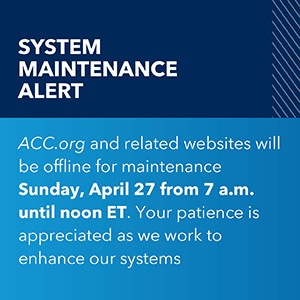How to Talk to Patients About Smoking
This post was authored by Lekshmi Santhosh, MD, Trevor Jensen, MD and Eric Stecker, MD, MPH, FACC, member of the ACC’s Prevention of Cardiovascular Disease Section.
There are many demands on clinicians’ time. But what distinguishes cardiologists is an unyielding commitment to engage in care that is proven to reduce morbidity and mortality. These efforts have paid off; the mortality rate from cardiovascular disease decreased 50 percent over 20 years, with half of that decline attributable to cardiovascular care. Few other specialties can point to such a dramatic impact.
But we can do better. Overall, 18 percent of American adults and 37 percent of cardiology patients still place themselves at significant risk by smoking. General cardiologists and subspecialists are in a unique position to focus patients’ attention on the benefits of quitting smoking at moments when they are maximally engaged in improving health. It can be very motivating for a patient to hear that the average person will extend his or her life by 4-10 years by quitting smoking! Even patients with many comorbidities experience improvements in length and quality of life from quitting smoking, often within six months.
So, how do you talk about smoking without adding an hour or two to your day? Actually, it’s simple. The first step is to remember to ask each patient whether he or she smokes. For inpatients, get in the habit of asking at the time of admission or initial consultation. For outpatients, either ask during every visit or make sure a staff member is assigned to prominently flag current smoking status. After asking, advise smokers to quit and help them to engage with someone with experience in facilitating smoking cessation. It’s fine to refer the patient to an expert, as long as you follow through. Consider using a statement such as, “I’d like you to engage with an expert in quitting smoking. Even if you aren’t ready now, they will provide you with information for when you are ready. Let’s follow-up on your progress when I see you next.”
Inpatients can take advantage of smoking cessation teams that are available in many hospitals. Alternatively, they can engage the professional quit-line used by outpatients (1-800-QUIT-NOW or www.smokefree.gov). Quit-lines will provide your patient with individualized coaching that is tailored to his or her favored mode of interaction, including smartphone apps with texting features. After an initial assessment, the counselor will evaluate your patient’s desire and eligibility for pharmacologic smoking cessation therapy. The counselor will provide information on free resources as well as resources provided by the patient’s insurer. If appropriate, your patient will be referred to his or her primary care provider for prescriptions or additional referrals.
Once you’ve experienced the pleasure of the anticipated health benefits from helping patients quit smoking, you may want to engage more deeply. Agency for Healthcare Research and Quality Guidelines outline evidence- and expert-based best practices (including the 5As: Ask, Advise, Assess, Assist, Arrange). Eventually you may even want to engage local health systems, insurers or your community-at-large to improve population health by supporting changes that will reduce tobacco use.
This post is part of a series of posts for American Heart Month. Check out the “Cost of Lighting Up” infographic below. To view a complete list of ACC infographics, visit ACC.org.

